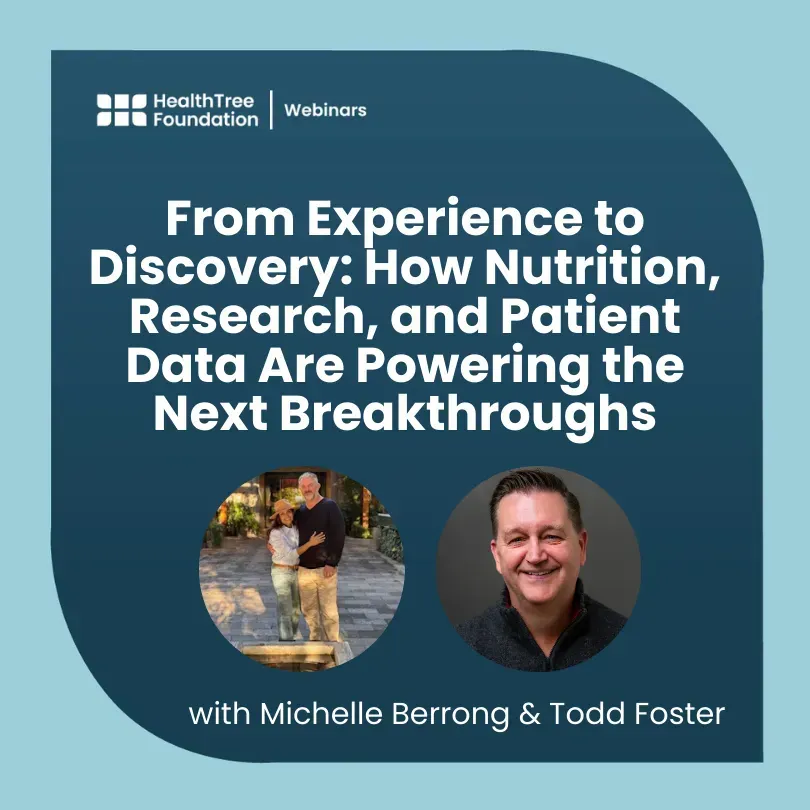ASH 2023: PERSEUS and IsKia Trials Support a New Standard of Care for Transplant Eligible Newly Diagnosed Myeloma Patients
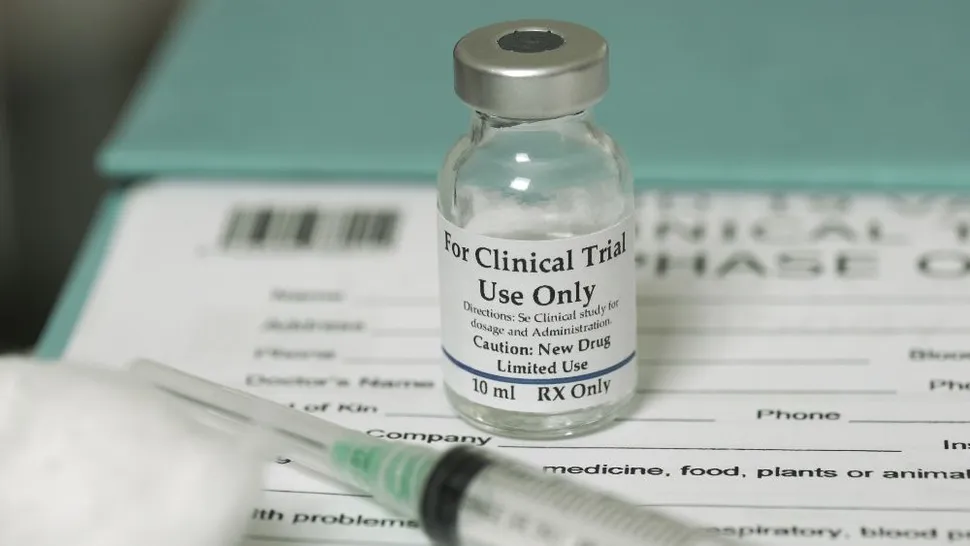
With over 7,000 abstracts accepted at this year’s ASH annual meeting, how is a doctor or patient to know which trials have the highest potential impact on clinical practice?
Fortunately, through a rigorous peer-review process, the scientific leaders select “high impact” abstracts to be presented at the greatly anticipated Late Breaking Abstract Session and the “top six” abstracts to be presented during the prestigious, Plenary Scientific Session.
This year, both the PERSEUS Trial and IsKia Trial were showcased as critically important research that many myeloma experts have described as “practice changing.”
These trials add to the growing body of evidence and expert opinion, that suggest the time is now to recognize “quadruplet therapy” as a standard of care for newly diagnosed, transplant-eligible myeloma patients.
PERSEUS Trial Highlights
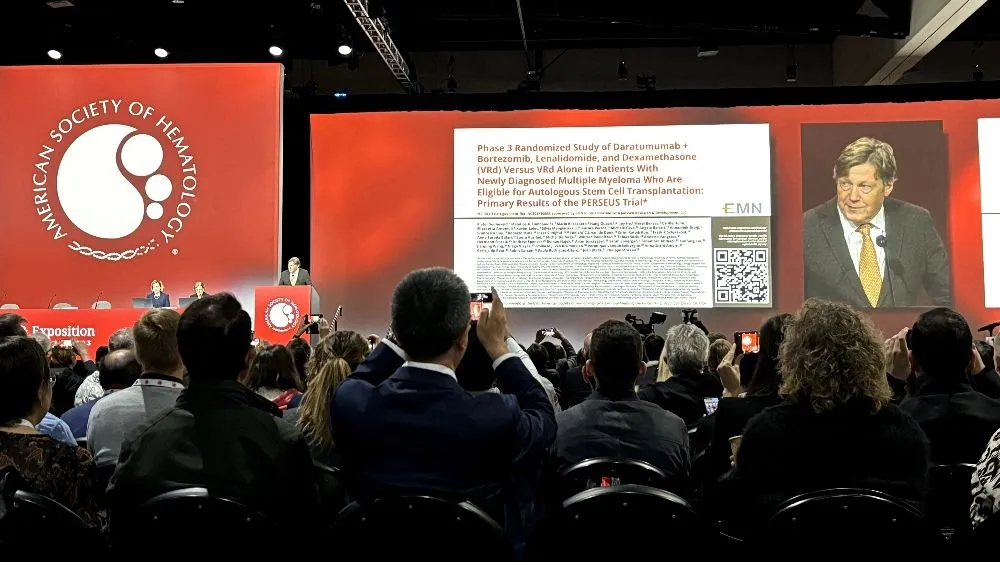
On Tuesday, December 11th Dr. Pieter Sonneveld, presented the primary analysis of the phase 3 PERSEUS Trial to a packed hall during the Late Breaking Abstract Session.
After the presentation, noted myeloma experts posted enthusiastic comments online.
Dr. Noopur Raje from Massachusetts General Hospital posted, “Unprecedented results with quad upfront as shown in PERSEUS study…a new standard of care.”
Dr. Rafael Fonseca from Mayo Clinic posted, “History in the making…superb results…”.
Dr. Nizar Bahlis from the University of Calgary posted, “Triumph of science and research.”
As further evidence of the significance of this research, after the presentation, Dr. Sonneveld announced that the trial was published simultaneously in the prestigious, New England Journal of Medicine. (Daratumumab, Bortezomib, Lenalidomide, and Dexamethasone for Multiple Myeloma | NEJM)
Study Results and Conclusions
Patients in the quadruplet arm of DARA [daratumumab subcutaneous] plus VRD [Velcade, Revlimid, dexamethasone] followed by daratumumab + Revlimid maintenance had an impressive 84.3% progression-free survival (PFS) at 48 months. This means that 84.3% did not experience relapse or progression of their disease for 4 years!
This study also provides valuable insight regarding “response-guided therapy” during maintenance. 64% of patients who received daratumumab + Revlimid maintenance for at least two years were able to stop daratumumab after achieving MRD negative for longer than a year.
IsKia Trial Highlights
On Sunday, December 10th, the IsKia trial was presented by Dr. Francesca Gay from the University of Torino, Italy, during the Plenary Scientific Session.
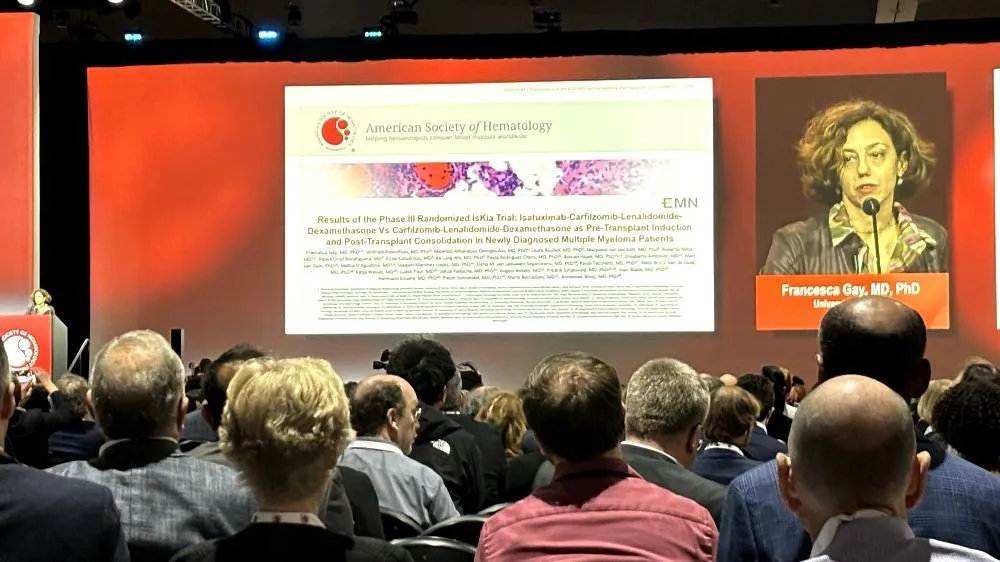
Study Design and Conclusions
302 patients were randomized to receive the treatment combinations of Kyprolis(K); Revlimid(R), Dexamethasone(d), and/or Isatuximab(Isa) as outlined below. The brand name of Isa is Sarclisa. MRD assessment was done after induction, transplant, and twice during consolidation. Patient characteristics were well-balanced between the treatment groups.
The primary endpoint was MRD negativity at the 105 level following post-transplant consolidation. The secondary endpoints include MRD negativity after induction, progression-free survival (PFS), and sustained MRD negativity.
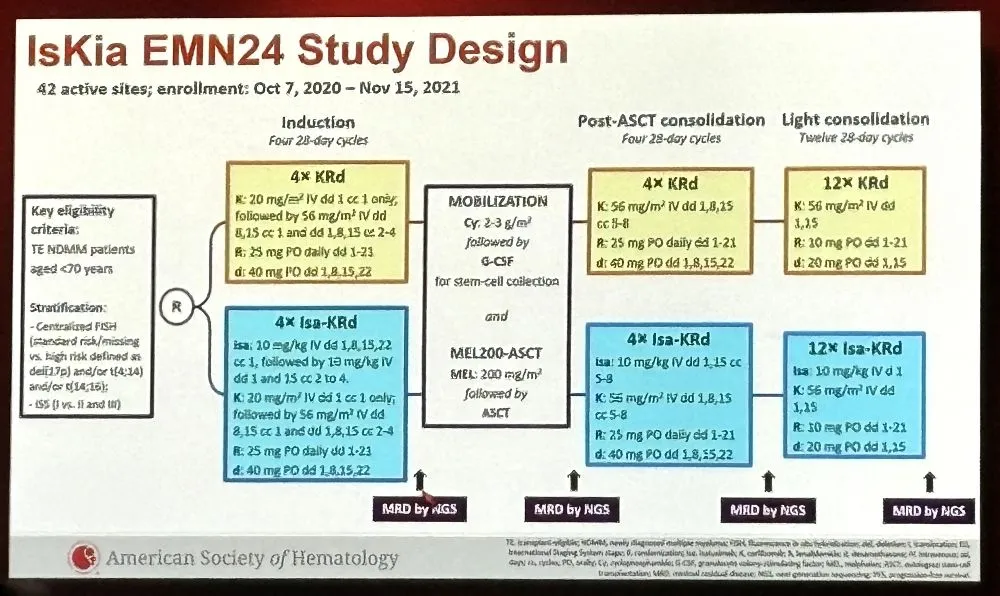
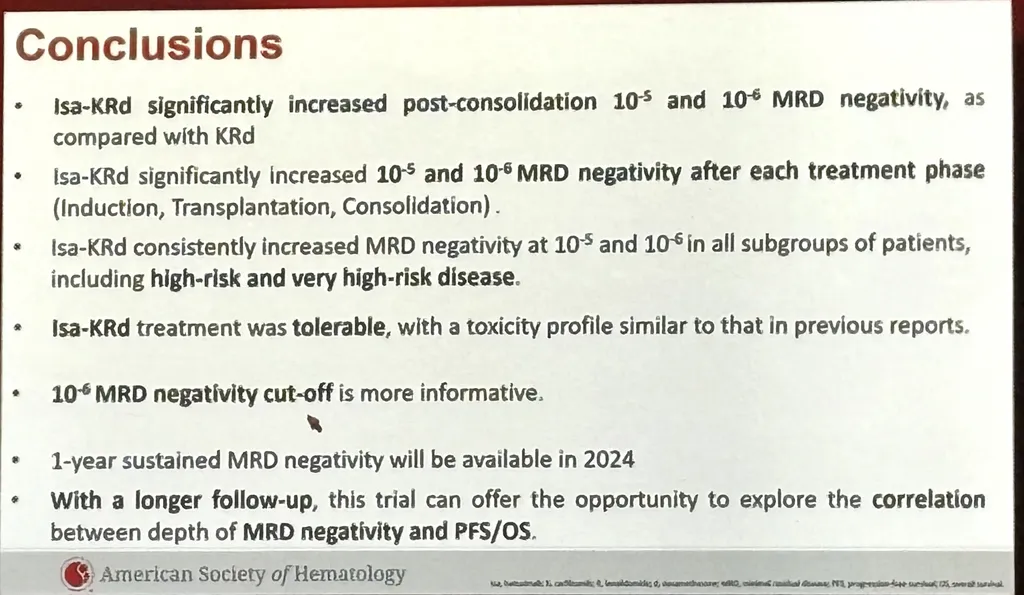
The authors concluded the quadruplet combination of isatuximab (isa) plus KRd [carflizomib, revlimid, dexamethasone], performed significantly better than the triplet combination of KRd when looking for any myeloma cells at the 105 level (1 in 100,000) or 106 level (1 in 1,000,000). The addition of isatuximab did not add any safety profile risks to the combination. This benefit was also shown in the high-risk myeloma patient population in the trial.
The results of the IsKia trial provide further evidence of the potential value of quadruplet therapy in transplant-eligible, newly diagnosed myeloma patients.
Key Considerations for Newly Diagnosed Transplant-Eligible Patients
Newly diagnosed myeloma patients who are eligible for transplant will want to consider the following points:
- Get a myeloma expert on your team. To ensure that your personalized treatment plan reflects the most recent research and rapidly evolving standard of care, we highly recommend getting a myeloma expert on your team. You can find a list of experts in your area through this link: Myeloma Specialist Directory
- Ask your doctor about the potential benefits and risks of including daratumumab or isatuximab in the induction, consolidation, or maintenance phases of your personalized treatment plan.
- As a coach, I have heard many stories about doctors that believe including daratumumab or isatuximab during initial treatment should be reserved only for high-risk patients, but note that the benefits described in PERSEUS and IsKia were seen in both standard and high-risk patients. As you talk with your doctor, demonstrate how educated and empowered you are by sharing your awareness of these two pivotal trials presented at ASH. Together you and your doctor can make a shared decision informed by the latest research and expert opinion.
- Carefully consider your intent to get a stem-cell transplant. Recognize that the encouraging results of PERSEUS and IsKia are based on treatment plans that include autologous stem cell transplant. Although many patients meet the criteria of “transplant eligible,” for various reasons, some eligible patients choose to opt-out of transplant.
- Certainly, there is tremendous excitement regarding newer therapies like CAR-Ts and bispecific antibody therapies. However, it is important to realize that access to those novel agents for newly diagnosed patients is currently available only via limited clinical trials.
- Therefore, for newly diagnosed patients making important decisions in 2024, it is worthwhile to carefully consider your decision on if and when to proceed with a transplant. Although personal stories and social media are abuzz with strong opinions for or against transplant, it is important to consider the latest scientific research and expert opinion. Ultimately, the decision lies with the patient.
- Ask your doctor about how MRD [minimal residual disease] can be tested during your next bone marrow biopsy. MRD assessment is a key element of many trials. including PERSEUS and IsKia, and is increasingly being recognized as a valuable way to support personalized treatment decisions for patients in the local clinic. Click here for information about MRD testing: Myeloma Patient MRD Perceptions
Conclusions
Based on the compelling results from PERSEUS and IsKia, it is unsurprising that these trials received high praise and accolades from the ASH scientific review committee and myeloma experts.
The results of these trials are reason to celebrate and have significant hope. Hope alone, however, is not enough. Since it can take time for the latest evidence to spread throughout academic and community practices, patients are encouraged to get educated and become empowered.
If you or someone you care for has been newly diagnosed, consider asking your doctor whether pivotal research, including PERSEUS and IsKia, is relevant to your specific case and if it is appropriate to incorporate these new insights into your personalized treatment strategy.
ASH 2023 Resources
Would you like to watch ASH 2023 myeloma research interviews from the investigators themselves? Click "ASH 2023" here: HealthTree University Conference Coverage
To read other ASH 2023 articles, click here: HealthTree 2023 ASH Articles
With over 7,000 abstracts accepted at this year’s ASH annual meeting, how is a doctor or patient to know which trials have the highest potential impact on clinical practice?
Fortunately, through a rigorous peer-review process, the scientific leaders select “high impact” abstracts to be presented at the greatly anticipated Late Breaking Abstract Session and the “top six” abstracts to be presented during the prestigious, Plenary Scientific Session.
This year, both the PERSEUS Trial and IsKia Trial were showcased as critically important research that many myeloma experts have described as “practice changing.”
These trials add to the growing body of evidence and expert opinion, that suggest the time is now to recognize “quadruplet therapy” as a standard of care for newly diagnosed, transplant-eligible myeloma patients.
PERSEUS Trial Highlights

On Tuesday, December 11th Dr. Pieter Sonneveld, presented the primary analysis of the phase 3 PERSEUS Trial to a packed hall during the Late Breaking Abstract Session.
After the presentation, noted myeloma experts posted enthusiastic comments online.
Dr. Noopur Raje from Massachusetts General Hospital posted, “Unprecedented results with quad upfront as shown in PERSEUS study…a new standard of care.”
Dr. Rafael Fonseca from Mayo Clinic posted, “History in the making…superb results…”.
Dr. Nizar Bahlis from the University of Calgary posted, “Triumph of science and research.”
As further evidence of the significance of this research, after the presentation, Dr. Sonneveld announced that the trial was published simultaneously in the prestigious, New England Journal of Medicine. (Daratumumab, Bortezomib, Lenalidomide, and Dexamethasone for Multiple Myeloma | NEJM)
Study Results and Conclusions
Patients in the quadruplet arm of DARA [daratumumab subcutaneous] plus VRD [Velcade, Revlimid, dexamethasone] followed by daratumumab + Revlimid maintenance had an impressive 84.3% progression-free survival (PFS) at 48 months. This means that 84.3% did not experience relapse or progression of their disease for 4 years!
This study also provides valuable insight regarding “response-guided therapy” during maintenance. 64% of patients who received daratumumab + Revlimid maintenance for at least two years were able to stop daratumumab after achieving MRD negative for longer than a year.
IsKia Trial Highlights
On Sunday, December 10th, the IsKia trial was presented by Dr. Francesca Gay from the University of Torino, Italy, during the Plenary Scientific Session.

Study Design and Conclusions
302 patients were randomized to receive the treatment combinations of Kyprolis(K); Revlimid(R), Dexamethasone(d), and/or Isatuximab(Isa) as outlined below. The brand name of Isa is Sarclisa. MRD assessment was done after induction, transplant, and twice during consolidation. Patient characteristics were well-balanced between the treatment groups.
The primary endpoint was MRD negativity at the 105 level following post-transplant consolidation. The secondary endpoints include MRD negativity after induction, progression-free survival (PFS), and sustained MRD negativity.


The authors concluded the quadruplet combination of isatuximab (isa) plus KRd [carflizomib, revlimid, dexamethasone], performed significantly better than the triplet combination of KRd when looking for any myeloma cells at the 105 level (1 in 100,000) or 106 level (1 in 1,000,000). The addition of isatuximab did not add any safety profile risks to the combination. This benefit was also shown in the high-risk myeloma patient population in the trial.
The results of the IsKia trial provide further evidence of the potential value of quadruplet therapy in transplant-eligible, newly diagnosed myeloma patients.
Key Considerations for Newly Diagnosed Transplant-Eligible Patients
Newly diagnosed myeloma patients who are eligible for transplant will want to consider the following points:
- Get a myeloma expert on your team. To ensure that your personalized treatment plan reflects the most recent research and rapidly evolving standard of care, we highly recommend getting a myeloma expert on your team. You can find a list of experts in your area through this link: Myeloma Specialist Directory
- Ask your doctor about the potential benefits and risks of including daratumumab or isatuximab in the induction, consolidation, or maintenance phases of your personalized treatment plan.
- As a coach, I have heard many stories about doctors that believe including daratumumab or isatuximab during initial treatment should be reserved only for high-risk patients, but note that the benefits described in PERSEUS and IsKia were seen in both standard and high-risk patients. As you talk with your doctor, demonstrate how educated and empowered you are by sharing your awareness of these two pivotal trials presented at ASH. Together you and your doctor can make a shared decision informed by the latest research and expert opinion.
- Carefully consider your intent to get a stem-cell transplant. Recognize that the encouraging results of PERSEUS and IsKia are based on treatment plans that include autologous stem cell transplant. Although many patients meet the criteria of “transplant eligible,” for various reasons, some eligible patients choose to opt-out of transplant.
- Certainly, there is tremendous excitement regarding newer therapies like CAR-Ts and bispecific antibody therapies. However, it is important to realize that access to those novel agents for newly diagnosed patients is currently available only via limited clinical trials.
- Therefore, for newly diagnosed patients making important decisions in 2024, it is worthwhile to carefully consider your decision on if and when to proceed with a transplant. Although personal stories and social media are abuzz with strong opinions for or against transplant, it is important to consider the latest scientific research and expert opinion. Ultimately, the decision lies with the patient.
- Ask your doctor about how MRD [minimal residual disease] can be tested during your next bone marrow biopsy. MRD assessment is a key element of many trials. including PERSEUS and IsKia, and is increasingly being recognized as a valuable way to support personalized treatment decisions for patients in the local clinic. Click here for information about MRD testing: Myeloma Patient MRD Perceptions
Conclusions
Based on the compelling results from PERSEUS and IsKia, it is unsurprising that these trials received high praise and accolades from the ASH scientific review committee and myeloma experts.
The results of these trials are reason to celebrate and have significant hope. Hope alone, however, is not enough. Since it can take time for the latest evidence to spread throughout academic and community practices, patients are encouraged to get educated and become empowered.
If you or someone you care for has been newly diagnosed, consider asking your doctor whether pivotal research, including PERSEUS and IsKia, is relevant to your specific case and if it is appropriate to incorporate these new insights into your personalized treatment strategy.
ASH 2023 Resources
Would you like to watch ASH 2023 myeloma research interviews from the investigators themselves? Click "ASH 2023" here: HealthTree University Conference Coverage
To read other ASH 2023 articles, click here: HealthTree 2023 ASH Articles

about the author
Todd Kennedy
Todd Kennedy was diagnosed with myeloma in 2017 and has become a tireless advocate for myeloma patients and research. His background includes over 30 years working in the pharmaceutical industry until he and his wife Diane retired from their respective first careers to devote their time and talents to strengthen the myeloma community. They collaborate with HealthTree and other trusted partners to educate and empower myeloma patients and caregivers and accelerate the arrival of cures.
More on Conferences
Trending Articles
Upcoming Events




Get the Latest Multiple Myeloma Updates, Delivered to You.
By subscribing to the HealthTree newsletter, you'll receive the latest research, treatment updates, and expert insights to help you navigate your health.
Together we care.
Together we cure.
3x Faster.












